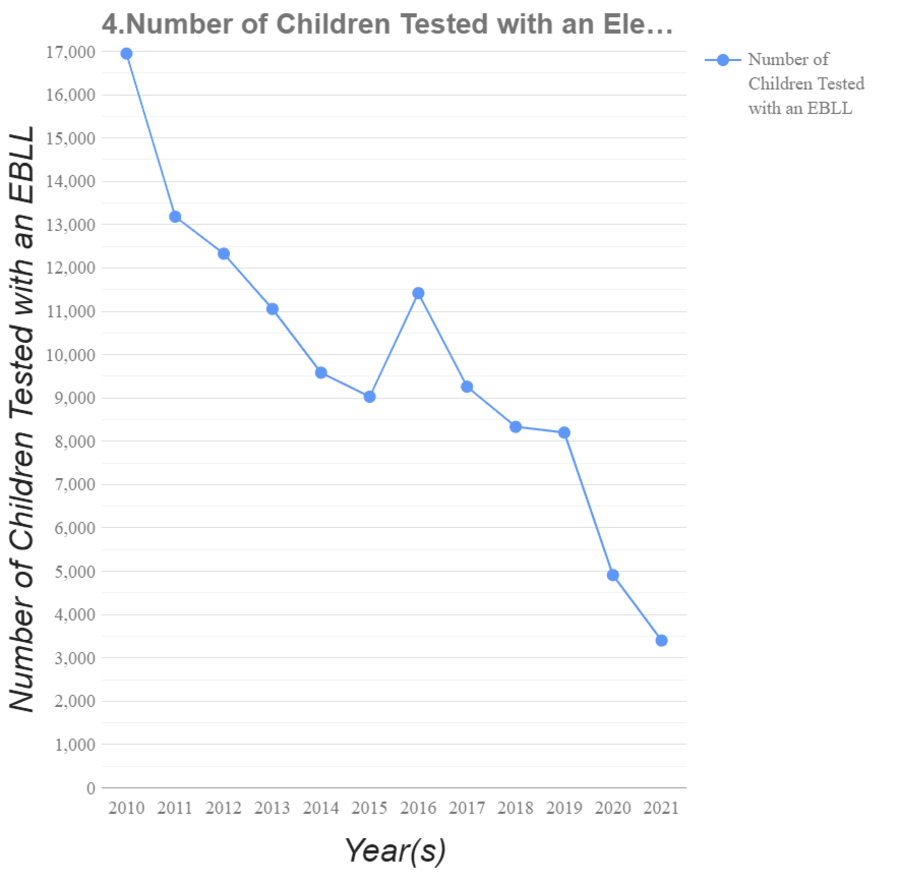DETROIT – Michigan has made blood lead data for children in the state with elevated blood lead levels (3.5 µg/dL and higher) available online through MiTracking.
Until now, the data had been available for blood lead levels of 5 µg/dL and higher. Michigan updated its definition of an elevated blood lead level in May, after the CDC updated their blood lead reference value (BLRV) from 5 ug/dL to 3.5 ug/dL. There is no safe level of lead in blood.
Recommended Videos
The BLRV is used to identify children with higher levels of lead in their blood compared to 97.5% of children in the United States. The BLRV is used as a tool to identify children who need public health services and medical evaluation. It is also used to prioritize communities that need help to reduce lead exposure.
“MDHHS is committed to preventing Michigan children from being exposed to lead,” said Dr. Natasha Bagdasarian, chief medical executive. “Public health officials, health care providers and the general public can access data to learn about prevalence of childhood blood lead levels in their communities and make informed decisions about prevention efforts for exposure to lead in children.”
More than 3,400 Michigan children had an elevated blood lead level of 3.5 µg/dL and higher in 2021. More than half of those children (1,907) had a blood lead level of 5 µg/dL and higher.
Here’s how you can view the data
You can view the data on the MiTracking data portal by clicking here.
Data is available at the state, county, local health department and zip code levels. Data goes back to 2010 and up to 2021.
You can view the data as a table, chart or map. Below is the chart of the number of children tested with an elevated blood lead level from 2010 through 2021.
To view the data for your county, you’ll want to choose the “switch to advanced query” option, select “zip code” and enter your zip code before running the query.

Click here to learn more about lead hazards, blood testing and lead services in Michigan.
How are children exposed to lead?
Lead exposure can come from several sources, according to the CDC:
- Homes built before 1978 (when lead-based paints were banned) probably contain lead-based paint. When the paint peels and cracks, it makes lead dust. Children can be poisoned when they swallow or breathe in lead dust.
- Certain water pipes may contain lead.
- Lead can be found in some products such as toys and jewelry.
- Lead is sometimes in candies imported from other countries or traditional home remedies.
- Certain jobs and hobbies involve working with lead-based products, like stain glass work, and may cause parents to bring lead into the home.
Are there symptoms of lead exposure?
Unfortunately, lead exposure in children is difficult to notice and most children have no obvious symptoms immediately.
According to the CDC, lead quickly enters the body and can cause harm. When a child swallows lead, their blood lead level rises. When the exposure stops, the amount of lead in the blood decreases over time.
Lead is released through urine, sweat and feces. Lead is also stored in bones and it can take decades for lead stores in the bones to decrease.
Read: Experts dive into why there’s an alarming increase in lead poisoning among children
Should I test my child for lead exposure?
Some children are more likely to be exposed to lead than others.
The best way to know if a child has been exposed to lead is to have their blood tested.
The first test is usually done by taking a finger-prick or heel-prick sample. If that test comes back positive, a second test is usually used to confirm. A blood draw test may be ordered to confirm the blood lead level seen in a test.
The CDC recommends that children who experience the following should be tested for lead:
- Live or spend time in a house or building built before 1978
- Are from low-income households
- Are immigrants, refugees, or recently adopted from less developed countries
- Live or spend time with someone who works with lead or has hobbies that expose them to lead
Children enrolled in Medicaid are required to get tested for lead at ages 12 and 24 months, or age 24-72 months if they have never been tested. Young children often put their hands or other objects in their mouth, which means they are more likely to be exposed to lead than older children.
Click here to learn more about blood lead testing in Michigan.
What are the effects of childhood lead exposure?
Children who have been exposed to lead may experience a lower IQ, a decreased ability to pay attention and underperformance in school.
The CDC said that there is evidence that childhood exposure can cause long-term harm.
Exposure to lead can cause the following:
- Damage to the brain and nervous system
- Slowed growth and development
- Learning and behavior problems
- Hearing and speech problems
The health effects of exposure are more harmful to children who are younger than six years old because they are still growing.
Read: Wayne County prosecutor considers next steps in Flint Water Crisis
Does Michigan offer services to help combat lead poisoning?
If your child has an elevated blood lead level you can contact a state, local or national program to apply for lead services.
Through lead services, someone will help you find and fix lead hazards, identify lead in drinking water hazards and lower your child’s elevated blood lead level.
Services previously offered to children with blood lead levels greater than or equal to 4.5 µg/dL, including nursing case management, home environmental lead investigations and lead abatement, will be expanded to eligible families and households with children with confirmed blood lead levels greater than or equal to 3.5 µg/dL.
Click here to see if you qualify for any state or local services.

